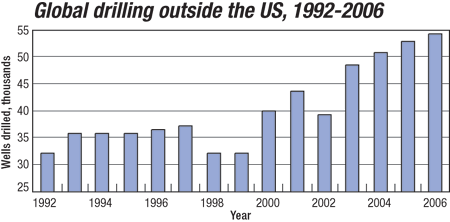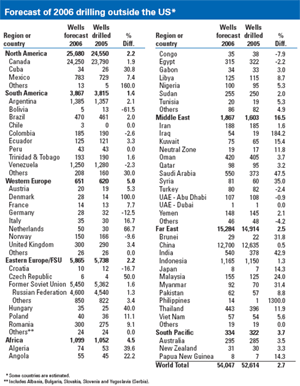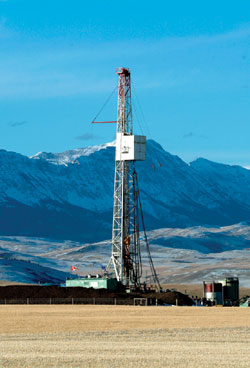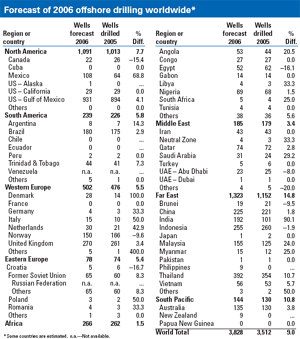OUTLOOK 2006: International
Worldwide drilling
Global drilling is at a 20-year high
The international upstream sector is contending with activity driven by high prices; problems with insufficient drilling rig capacities; shortages of qualified personnel to man additional rigs and platforms; and escalating costs for just about everything associated with drilling or development.
As the rig shortage worsens, and day rates rise even further, many newly planned international projects may not materialize on their original timing. The lack of available rigs to expand activity will also serve as “cover” for shortages of other key supplies and services needed to drill and complete key projects. And the rig problem is equally difficult on land. In markets outside the US, competition has been stiff for what few land rigs have been available on the market. A key player in bidding up the cost of land rigs has been Saudi Arabia.
 |
Meanwhile, the cost for many items is escalating quarterly, if not monthly. In addition to high rates for rigs, there is the cost of steel, which some analysts say has gone up 20% in the last year. And something as mundane as expenses for moving equipment and supplies by air freight or ship has gone up anywhere from 15% to 25%. Nevertheless, despite all these factors, operating companies are extremely optimistic. To take advantage of high oil and gas prices, many have very ambitious plans.
 |
| |
Forecast of 2006 drilling outside the US*
Click image for enlarged view |
|
|
|
Global drilling outside the US last year was up 2.3%, at 52,614 wells. Thanks to near-record oil and gas prices, gains in global demand, and political instability in key regions, we expect worldwide drilling to reach levels not seen in the last 20 years. Our forecast calls for wells drilled outside the US to increase about 3%, to just over 54,000. During 2006, every region should increase.
Offshore activity is forecast to increase a hefty 9%, to more than 3,800 wells. We expect every offshore region to register an increase. Strongest growth will be in the Far East, as well as the South Pacific. The offshore recovery begun in Western Europe a couple of years ago will also continue.
NORTH AMERICA
 |
Canada anticipates another drilling record for 2006 at 24,250 wells. Drilling for natural gas remains the driver. Photo courtesy of Tesco Corp.
|
|
In Canada, drilling records are still being set. Last year’s 23,000-plus wells broke 2004’s record, and our forecast anticipates another record for 2006 at 24,250 wells. Although contractor and vendor capacities have been an issue, manufacturers are adding new rigs, so a moderate increase seems achievable. Building natural gas supplies is still the dominant driver, but slightly more wells will target oil this year.
World Oil’s survey of 30 Canadian operators, representing 52% of all activity, indicates that gas drilling’s share of activity will remain at about 80%. The numbers also show a slight decrease in exploratory drilling, with 9% of wells drilled falling in that category. This represents a continuation of the decade-long trend toward development drilling in Canada.
Mexico. State firm Pemex kept drilling levels elevated by continuing to push forward with development of new gas production capacity in the Burgos basin. Pemex has budgeted $10 billion to $12 billion, annually, for oil and gas exploration and production in the next few years, of which $1.2 billion this year will be spent on natural gas projects in Veracruz state. Compared to previous years, a larger share of drilling is targeted to oil, particularly offshore. Indeed, Mexico’s offshore wells should jump 70%, while drilling, overall, will gain 7%.
Others. In Cuba, gains in both exploration and development drilling will fuel a 31% increase to 34 wells. An oil discovery in Belize last year will make that country the largest driller in Central America this year. Development drilling will push the total to 10 wells.
SOUTH AMERICA
South American activity was up more than 9% last year. This year, the momentum will slow to just a 1.5% increase. Some of the reasons have to do with capacity constraints, as well as rising costs. Nevertheless, most countries will eke out small gains.
The continent is a study in contrasts between the market-friendly approach taken by some countries and the nationalistic strategy pursued by others. Examples of the market approach include Brazil, Colombia and Peru. Venezuela, Argentina and Bolivia are examples of the less-industry-friendly, nationalistic approach. These countries have responded to high oil and gas prices by increasing state control over the industry and hiking taxes and royalties.
Argentina. Drilling should gain 2.1%, to 1,385 wells after a 9% jump last year. Included in the total were 1,050 oil completions and 160 gas wells. As was the case in 2004, much of the gain is due to ongoing field developments and production expansions by several operators. A number of independents had exploration successes, particularly in the Neuquén basin.
Venezuela. Among nations taking the nationalistic approach, Venezuela is the chief offender, where the bombastic president, Hugo Chavez, has squeezed oil companies with little regard for signed contracts. Chavez has increased royalties and forced operators to accept joint venture agreements with state company, PDVSA. We expect drilling to be flat or down slightly this year at 1,250 wells, as some foreign operators retrench a bit in light of the changes forced upon them. Six offshore exploration and production licenses were awarded in the first two stages of the Rafael Urdaneta project to increase gas output in western Venezuela.
Brazil. Wells drilled improved 1.3% last year, including 175 offshore. Rigs running rose to 27 from 25.5. This year, a further small increase to 470 wells is predicted, including another 175 wells offshore. Brazil last October held its 7th annual licensing round, and 251 blocks were awarded out of a record 1,134 on offer. Most of the blocks offered have more chance of finding gas than oil.
Colombia. Activity last year was virtually unchanged at 190 wells. For 2006, drilling will be even or slightly lower. Colombia has been promoting its potential aggressively, and the country signed more than 50 E&P contracts last year. Whether this will help to build back production and reserves remains to be seen.
Trinidad. Drilling was up 9.8%, and a further, small gain is on tap this year. Offshore activity totaled 41 wells, and a minor increase to 44 wells is forecast. Gas development projects, including those tied to LNG infrastructure, continue in earnest.
Others. In Suriname, state firm Staatsolie anticipates the drilling of 197 wells, up from 152 last year. Of the amount forecast, 45 wells will be for exploration. After a hiatus, drilling offshore the Falkland Islands will resume with three wells, and a rare wildcat will be drilled offshore French Guiana. In Chile, state company ENAP expects to resume drilling with a three-well exploration program onshore.
 |
| |
Forecast of 2006 offshore drilling worldwide
Click image for enlarged view |
|
|
|
WESTERN EUROPE
The recovery continues in Western Europe, as operators take advantage of high prices to make projects more economic. Activity finished slightly higher than our updated forecast last September, rising nearly 12%. This year, we expect the region to be up 5%. The region is riding higher on the backs of renewed strength in the Netherlands, Denmark and Italy. Offshore drilling will be up 5.5%, again thanks to these countries.
United Kingdom. There is great concern about maintaining the recovery in upstream activity that the Department of Trade and Industry has so carefully nurtured since the first 10% tax surcharge was levied on operators in April 2002. To its credit, DTI initiated new types of licenses designed to attract new operators, particularly independents. That move and others has helped to rebuild activity levels, as have higher oil and gas prices. But all this good news is threatened by the Chancellor of the Exchequer, who slapped another 10% surcharge on operators last month. This is a move that the UK Offshore Operators Association described as “almost beyond comprehension.” It will be interesting to see how the effects stack up over the next 12 months. In the short run, we do expect a small increase to 300 wells, which is the highest total since 2002.
Norway. Like the UK, the issues are also taxation, along with leasing policies and availability of new parcels to explore. None of these issues has been addressed to the satisfaction of operators, and the situation is reflected in a prediction by the Norwegian Petroleum Directorate that there will be a 10% drilling decline this year. On the positive side, there will be a momentary improvement in exploratory drilling of about 30%, albeit to 17 wells.
EASTERN EUROPE/ FSU
Within the Former Soviet Union, incremental progress continues, as Russia has rebuilt its oil production rate back to over 9 million barrels per day. However, things have slowed down, despite high prices, and the drilling pace is far less than the double-digit percentage increases of several years ago. Regionally, wells will be up 2.2%, but only 1.6% in the FSU.
Russia. Officials continue to worry about a lack of sufficient exploration drilling. Most of the 1.5% increase in their drilling came from development work. There are also continuing distractions for the resident operators, in terms of bureaucratic intervention and the possibility that some additional mergers may be necessary. A 1.3% increase in wells is expected.
Other FSU countries. Activity was rather flat last year, but drilling outside Russia is expected to gain more than 3% in 2006. The situation in the rest of the Former Soviet Union continues to be more positive, particularly in Kazakhstan and Azerbaijan, where large development projects have resulted in significant new supplies of oil and gas coming onstream. Lithuania will nearly double drilling at 11 wells, while Georgia expects to maintain 2005’s level at five wells.
Countries outside the FSU. In the smaller countries of Eastern Europe, activity is showing some signs of life, as exploration tries to shore up declining reservoirs.
AFRICA
Africa remained above the 1,000-well mark last year, thanks to a diverse mix of exploration and development projects, as well as a spread between onshore and offshore. This year, we expect a 5% increase, thanks to improvement in Algeria, Angola and Libya.
Egypt. As the leading driller, Egypt tallied 322 wells last year. For 2006, another 315 wells are forecast. State-owned Egyptian General Petroleum Corp. said that offshore activity accounted for 62 wells, including 27 oil completions and 30 gas wells. This year, offshore wells are forecast to total 52, including nine exploration wells. Onshore exploration wells are expected to total 38.
Angola. Drilling failed to meet predictions, slipping below 2004’s level, to 45 wells. Average rigs running declined to 2.9 from 3.2, almost all of it offshore. This year, a 22% rebound to 55 wells is forecast, assuming that enough rigs can be maintained in the area. Although development work is the majority share, some exploratory successes continue. Marathon announced its ninth deepwater discovery on Block 31.
Algeria. Drilling activity was off some more last year, but it appears that the bottom has been hit. The Ministry of Energy & Mines predicts a 40% gain, including some improvement in exploratory drilling. Crude oil and condensate reserves are now estimated at 11.35 million bbl. Gas reserves are in the vicinity of 160 Tcf.
Other countries. In terms of total wells drilled, Sudan remains the number two driller behind Egypt. With the re-entry of US firms and the large amounts of investment expected, Libya could very well be the largest source of upstream growth in Africa a year from now.
MIDDLE EAST
The Middle East is robust, due to a significant increase in Saudi Arabia’s activity. Overall, the region will be up 16.5%.
Saudi Arabia. The kingdom has been aggressive about bringing in more drilling rigs, and Saudi Aramco recently approved a master plan that calls for a 61% increase in development drilling, as the country tries to add at least another million barrels of daily capacity. To accomplish this, Aramco officials have been very competitive in procuring land rigs on the open market, offering top dollar to lure foreign-owned rigs into the kingdom.
Oman. The sultanate is no longer the leading driller in the region, although it did tally 405 wells. This year, a slight increase to 420 wells is forecast. Dominant operator PDO continues to engage in heavy development work to shore up oil output while also exploring for new fields. Not completely satisfied with PDO, the government awarded a field development contract to Occidental.
Iran. State firm N.I.O.C. said it set a new record for footage drilled in a 9-month period during the first nine months of 2005. Accordingly, wells drilled rose to 185. A slight gain to 188 wells is forecast this year. Offshore, there were 43 wells, a level that should continue this year.
Iraq. As activity began to rebuild, 19 development wells, all oil completions, were drilled last year. For 2006, official sources told World Oil that a large increase to 54 wells is expected. Included in the total will be four exploration wells. Average well depth is 1,000 to 3,500 m.
FAR EAST
In the Far East, China’s activity dominates the regional drilling performance. Regional activity will be up across the board, with solid increases anticipated for India, Thailand, Myanmar and Malaysia. Exploration continues to outperform the world average, and some exciting discoveries have been made. The Far East will have the best offshore improvement this year, with a 15% increase predicted, to more than 1,300 wells; this is more than all offshore activity in North America.
China. The major state firms, CNPC, Sinopec and CNOOC, combined for a well total above 12,600 wells. This year, they should approach 12,700 wells, as they strain capacity again. Offshore, CNPC and its foreign partners drilled 221 wells, and another 225 are forecast this year. At the large oil find made in the Jidong tidal and shallow water areas of Bohai Bay, additional exploration wells found more quantities of oil and gas. Also, in the deep layer at Daqing field, CNPC discovered sizeable natural gas reserves.
India. Activity failed to live up to expectations, with only 378 wells drilled. Of that number, 101 were offshore. This year, the director general of hydrocarbons predicts a rebound to 540 wells, including 192 offshore. Also, 253 of the wells, both onshore and offshore, will be for exploration.
Indonesia. The country remains a quandary for many operators. Despite a solid history and some good, remaining prospects, companies are still not happy with the regulatory terms, and despite promises to the contrary, the government has yet to fully overhaul the regulatory structure. Thus, we predict only a 1% increase for Indonesia.
SOUTH PACIFIC
South Pacific nations will all equal, or do better than, their performances last year. Drilling during 2005 was better than expected, finishing 16% higher than in 2004. Offshore activity in the region remains quite healthy, and an 11% gain is forecast.
Australia. Offshore activity, particularly for gas development, is a strong driver for Australia, equaling nearly half of the well total. Overall, the country’s drilling will be up 3.5%. Onshore, the state of Queensland achieved a high well total last year at 185. A further increase to 190 is predicted, including 30 exploration wells. Northern Territory’s offshore drilling will receive a boost to 11 wells from eight in 2005. This year’s total will include eight exploration wells.
New Zealand. The Crown Minerals Department said that 30 wells were drilled, all onshore. Activity will remain strong this year at 31 wells, including nine offshore. Exploration is making a comeback, accounting for 16 wells (12 onshore and four offshore). 
|






